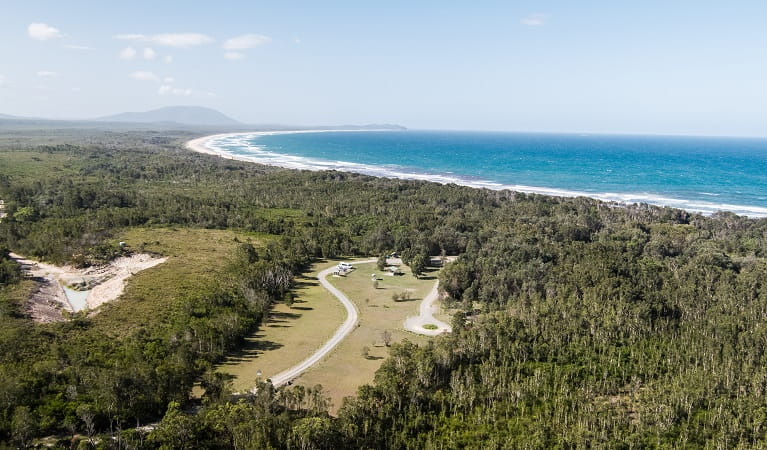Crowdy Gap campground
Crowdy Bay National Park
Overview
A good spot for group camping trips, set up your tent, RV or caravan at Crowdy Gap campground, between Taree and Port Macquarie. The beach is just a short walk away.
| Number of campsites | 10 |
|---|---|
| Camping type | Tent, Camper trailer site, Caravan site, Camping beside my vehicle |
| Facilities | Picnic tables, barbecue facilities, carpark, toilets, outside shower |
| What to bring | Drinking water, cooking water |
| Entry fees |
Park entry fees are not included in your camping fees. |
| Group bookings | Bookings for up to 5 sites and 20 people can be made online. School groups and commercial tour operators can submit a group booking enquiry form. |
| Please note |
|
The only campground at the southern end of Crowdy Bay National Park, Crowdy Gap campground is located behind the sand dunes on the edge of Crowdy Bay on the site of an old dairy farm.
Set up camp among the banksias and pink-barked angophoras, inhale the fresh coastal breeze, and unpack your swimmers for a beachside camping holiday. It’s an easy walk through lush rainforest and sand dunes to Crowdy Beach. Spend your days diving into the clear blue waves, fishing, and walking the golden beaches. As the sun sets, gather together and cook up your catch over the barbecue.
A place of significance to the local Birpai Aboriginal People, shell middens are dotted through the dunes, indicating this was an area of plenty for fish, shellfish and wallabies.
Take a virtual tour of Crowdy Gap campground captured with Google Street View Trekker.
Map
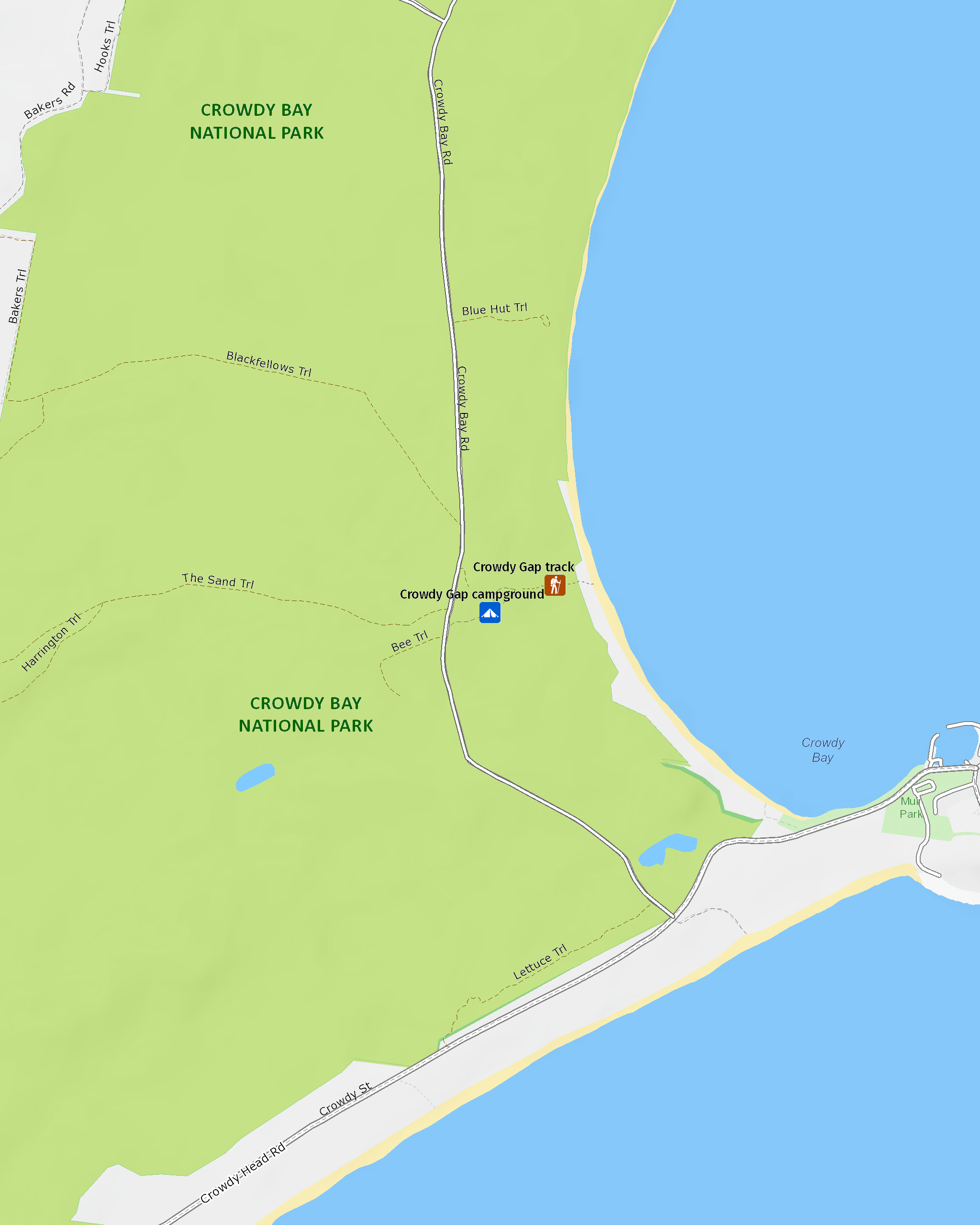
Map legend

Local alerts
For the latest updates on fires, closures and other alerts in this area, see https://www.nationalparks.nsw.gov.au/camping-and-accommodation/campgrounds/crowdy-gap-campground/local-alerts
Bookings
- National Parks Contact Centre
- 7am to 7pm daily
- 1300 072 757 (13000 PARKS) for the cost of a local call within Australia excluding mobiles
- parks.info@environment.nsw.gov.au
Park info
- in Crowdy Bay National Park in the North Coast region
Crowdy Bay National Park is always open but may have to close at times due to poor weather or fire danger.
-
Park entry fees:
$8 per vehicle per day.
Buy annual pass.
Visitor info
All the practical information you need to know about Crowdy Gap campground.
Getting there and parking
Crowdy Gap campground is in the southern section of Crowdy Bay National Park. There are 3 routes:
- Via Harrington along Crowdy Head Road and Crowdy Bay Road
- Via Moorland along Coralville Road and Crowdy Bay Road
- Via Laurieton along Diamond Head Road, Coralville Road and Crowdy Bay Road.
Road quality
- Unsealed roads
Vehicle access
- 2WD vehicles
Parking
There is a maximum of 2 vehicles (including caravans and camper trailers for vehicle-based sites) per site. Parking is permitted in the designated parking area adjacent to your campsite.
Limited additional parking is available in gravel carparks at the campground.
Best times to visit
Crowdy Bay National Park generally enjoys a warm subtropical climate. However outside of winter the temperature can reach above 30C, so be sure to carry sunscreen, a hat and plenty of water. Drinking water is not available within the park. Winter days and nights can be cool to cold, particularly in exposed areas of the park.
Spring
Wildflowers paint the dunes and heath in spectacular colour during spring.
Summer
Swimming, boating and fishing – enjoy the delights of Crowdy Bay's magnificent beaches. Look out for the festive Christmas Bell blooms.
Winter
Remember your binoculars and camera to experience the sight of migrating whales.
Weather, temperature and rainfall
Summer temperature
Average
19°C and 25°C
Highest recorded
43.3°C
Winter temperature
Average
10°C and 19°C
Lowest recorded
-1.7°C
Rainfall
Wettest month
February and March
Driest month
September
The area’s highest recorded rainfall in one day
310mm
Facilities
- Campsites are marked and most are suitable for tents only. Limited sites are available for small caravans (under 15ft/4.6m), camper trailers and campervans.
- There are no powered sites
- Drinking water is not available
- We encourage you to take your rubbish with you
- Please be considerate of others and keep noise low. Noise restrictions apply from 10pm.
Toilets
- Non-flush toilets
Picnic tables
The picnic tables come with picnic shelters.
Barbecue facilities
Each campsite has a fire ring. You can buy firewood and ice from the office at Diamond Head campground. Collecting firewood from the park is not permitted.
- Gas/electric barbecues (free)
- Fire rings (bring your own firewood)
Carpark
Outside shower
There's an outdoor cold-water shower at the campground.
Step-free access
The campground is flat and step-free, with a gravel pathway that leads to the amenities block. To reach the other areas of the campground, you'll need to cross over flat grass.
- Step-free outdoor pathways
Maps and downloads
Fees and passes
Park entry fees are payable at the campground through the self-registration envelopes (cash only) or at the Diamond Head campground onsite office. Annual passes are available to be purchased at the Diamond Head campground onsite office or online prior to your arrival.
- All Parks Pass - For all parks in NSW (including Kosciuszko NP) $190 (1 year) / $335 (2 years)
- Multi Parks Pass - For all parks in NSW (except Kosciuszko) $65 (1 year) / $115 (2 years)
- Country Parks Pass - For all parks in Country NSW (except Kosciuszko) $45 (1 year) / $75 (2 years)
- Single Country Park Pass - For entry to a single park in country NSW (except Kosciuszko). $22 (1 year) / $40 (2 years)
Accessibility
Disability access level - medium
Crowdy Gap campground is flat and step-free, with a gravel path that leads to the amenities block.
The campground has an accessible toilet with a timber ramp that leads to the entrance. You can reach the ramp by crossing over the gravel section at the start of Crowdy Gap walking track.
There are some parts of the campground where people with reduced mobility may need assistance:
- The campground is gravel-based and uneven in places
- You'll need to cross over flat grass to reach most parts of the campground including the picnic tables, barbecue shelters and outdoor shower.
- There is no wheelchair access to the beach
Permitted
Camp fires and solid fuel burners
Fires are permitted in the designated fire pits only. All other types of campfires are not permitted.
Fishing
Spear fishing is permitted in designated areas only.
Prohibited
Amplified music is not permitted.
Chemical toilets are not permitted.
Gathering firewood
Generators
Pets
Pets and domestic animals (other than certified assistance animals) are not permitted. Find out which regional parks allow dog walking and see the pets in parks policy for more information.
Smoking
NSW national parks are no smoking areas.
Learn more
Crowdy Gap campground is in Crowdy Bay National Park. Here are just some of the reasons why this park is special:
Gifts of nature
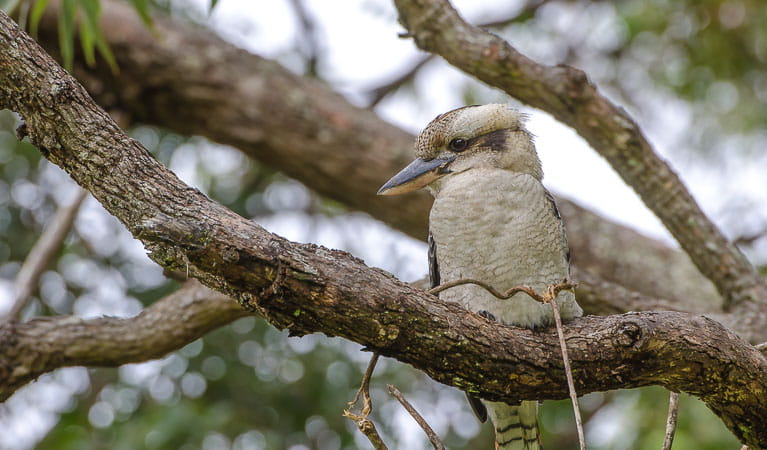
The views may grab the headlines, but within the park are more secretive delights that change with the seasons. These include rolling dunes that spring to life with wildflowers and migratory birds that populate the lagoons. There are lots of great lookouts to spot whales from as they migrate along the coast in winter or watch ospreys and falcons circle in the skies. Not to mention, kangaroos, koalas and cockatoos galore. Christmas visitors will receive an extra gift, Crowdy Bay's famous festive season blooms of Christmas bells.
- Mermaid lookout track Mermaid lookout track takes you on a tour of Crowdy Bay National Park's secret surprises. Secluded coves, sweeping beaches and mountain views await you on this short hike.
- Metcalfes walking track Get up close with nature on Metcalfes walking track, which links Indian Head and Kylies Beach in Crowdy Bay National Park. It's a family friendly hike and the kids might even spot a koala.
Past present
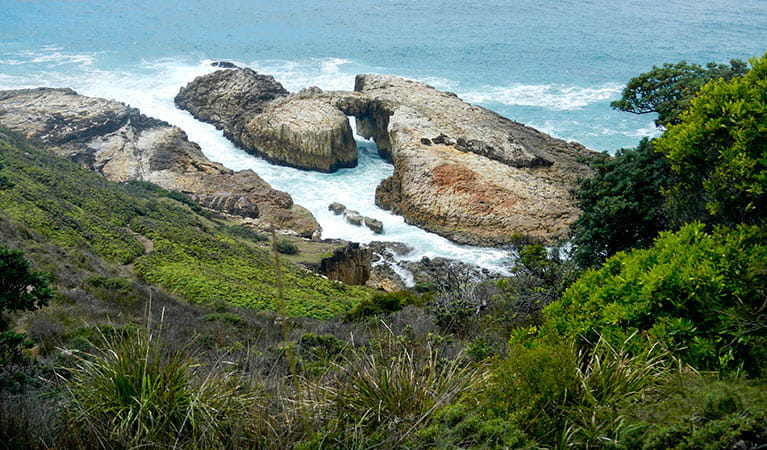
The Birpai People have climbed the headlands, swum in the rivers, crossed the sand dunes and walked the beaches of Crowdy Bay National Park for thousands of years. The sea and forest areas were a rich food source for the Birpai People, providing fish, shellfish, wallabies and berries. The park protects a number of Aboriginal sites, like shell middens and campsites, the oldest of which are about 6,000 years old. The park continues to be an important place for local Aboriginal people today.
Postcard perfect
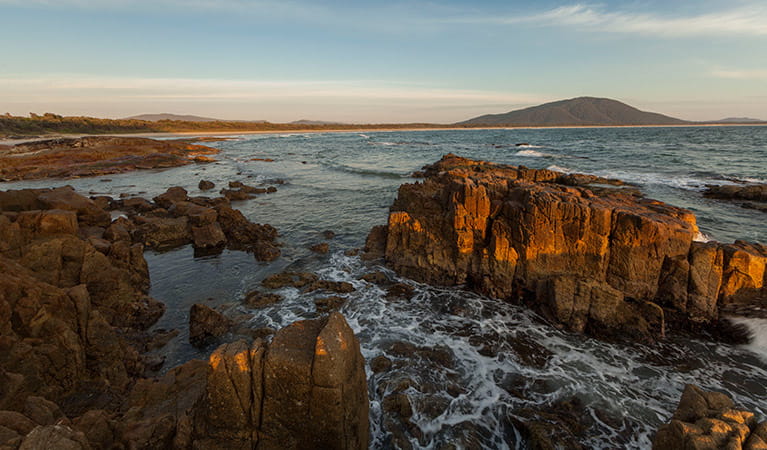
This spectacular environment is truly something to write home about. If you can't find the words, try these - panoramic, breathtaking, even gobsmacking. Then again, you'll probably be too busy exploring the tracks, gazing agape at the huge rock arches, communing with wildlife or throwing a line to write lines on a postcard.
- Crowdy Gap walking track The short and sweet Crowdy Gap walking track in Crowdy Bay National Park, near Taree, offers a stroll through rainforest with scenic views and the chance to see koalas.
- Diamond Head Loop walk Diamond Head loop walk offers scenic coastal views across Crowdy Bay National Park. Expect beaches, lookouts, and glinting rock faces, giving Diamond Head its name.
Writers' retreat
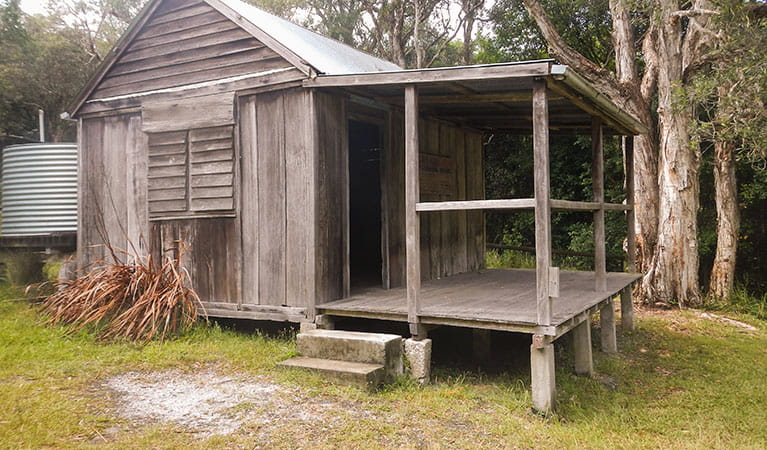
During World War II, the Australian author Kylie Tennant moved to Laurieton where she met the reclusive Ernie Metcalfe, a farmer who grazed cattle on Diamond Head. Ernie built Kylie a timber slab hut to use as a writer's retreat. In return, Kylie portrayed Metcalfe and Crowdy Bay in the book The Man on the Headland. Kylie Tennant donated the hut and the surrounding land to Crowdy Bay National Park in 1976. If you're walking along Metcalfe walking track, stop to have a look inside Kylie's hut.
- Kylies Hut Visit Kylies Hut along Metcalfes walking track in Crowdy Bay National Park, near Port Macquarie. The historic hut was used as a writer’s retreat by award-winning Australian novelist Kylie Tennant.
Plants and animals protected in this park
Animals
-

White-bellied sea eagle (Haliaeetus leucogaster)
White-bellied sea eagles can be easily identified by their white tail and dark grey wings. These raptors are often spotted cruising the coastal breezes throughout Australia, and make for some scenic bird watching. Powerful Australian birds of prey, they are known to mate for life, and return each year to the same nest to breed.
-
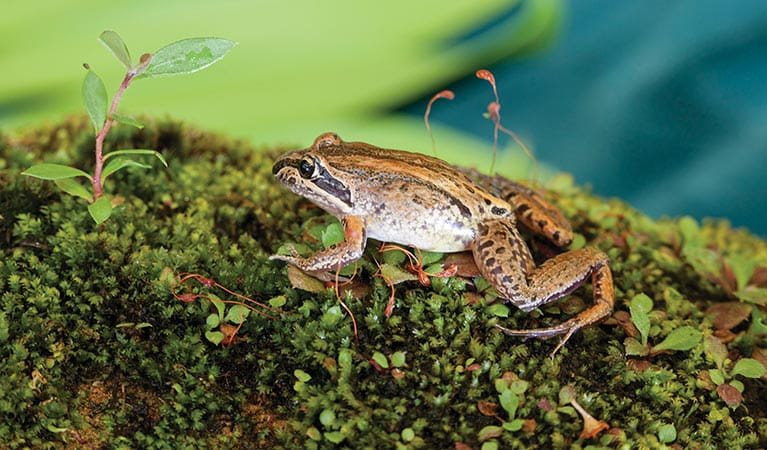
Brown-striped frog (Lymnastes peronii)
One of the most common frogs found in Australia, the ground-dwelling brown-striped frog lives in ponds, dams and swamps along the east coast. Also known as the striped marsh frog, this amphibian grows to 6.5cm across and has a distinctive ‘tok’ call that can be heard all year round.
-
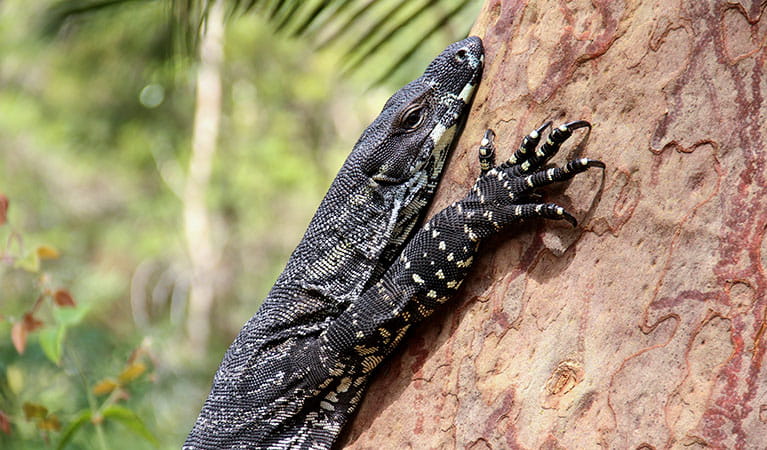
Lace monitor (Varanus varius)
One of Australia’s largest lizards, the carnivorous tree-dwelling lace monitor, or tree goanna, can grow to 2m in length and is found in forests and coastal tablelands across eastern Australia. These Australian animals are typically dark blue in colour with whitish spots or blotches.
Plants
-
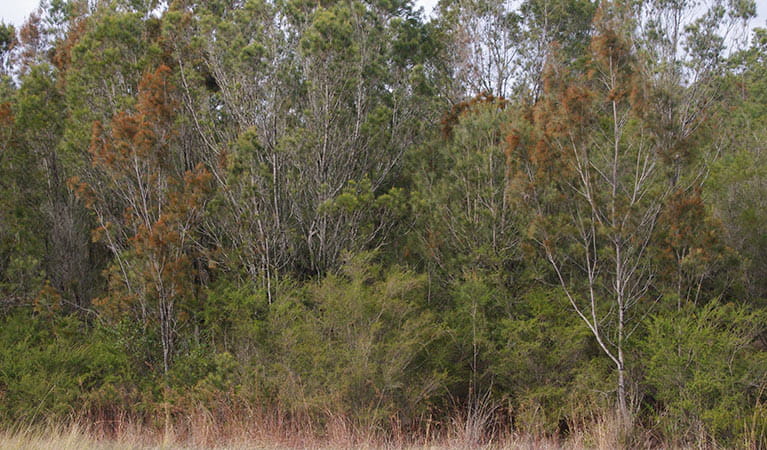
Black sheoak (Allocasuarina littoralis)
The black sheoak is one of a number of casuarina species found across the east coast of Australia and nearby tablelands. Growing to a height of 5-15m, these hardy Australian native plants can survive in poor or sandy soils. The barrel-shaped cone of the black sheoak grows to 10-30mm long.
-

Grass tree (Xanthorrea spp.)
An iconic part of the Australian landscape, the grass tree is widespread across eastern NSW. These Australian native plants have a thick fire-blackened trunk and long spiked leaves. They are found in heath and open forests across eastern NSW. The grass tree grows 1-5m in height and produces striking white-flowered spikes which grow up to 1m long.

